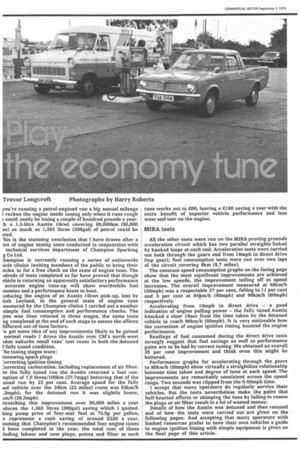rou're running a petrol-engined van a big annual mileage reckon
Page 62

If you've noticed an error in this article please click here to report it so we can fix it.
the engine needs tuning only when it runs rough I could easily be losing a couple of hundred pounds a year. ;h a 1.3-litre Austin lOcwt covering 80,000km (50,000 es) as much as 1,363 litres (300ga1) of petrol could be ;ted.
'his is the stunning conclusion that I have drawn after a ies of engine tuning tests conducted in conjunction with technical services department of Champion Sparking g Co Ltd.
:hampion is currently running a series of nationwide• tide clinics inviting members of the public to bring their &ides in for a free check on the state of engine tune. The tdreds of tests completed so far have proved that though abide is returning an apparently satisfactory performance accurate engine tune-up will show worthwhile fuel amities and a performance boost to boot.
teducing the engine of an Austin 1 Ocwt pick-up, lent by tish Leyland, to the general state of engine tune :ountered by the Champion clinics I carried out a number simple fuel consumption and performance checks. The One was then retuned in three stages, the same tests ng completed at the end of each stage to assess the affects lifferent out-of-tune factors.
'o get some idea of any improvements likely to be gained normal roads I drove the Austin over CM's north-west idon suburbs small vans' test route in both the detuned i fully tuned condition.
he tuning stages were: tenewing spark plugs :orrecting ignition timing :'.orrecting carburation, including replacement of air filter. )n the fully tuned run the Austin returned a fuel connption of 7.5 litres/100km (37.7mpg) bettering that of the .uned run by 23 per cent. Average speed for the fully led vehicle over the 34km (22 miles) route was 53km/h .2mph); for the detuned run it was slightly lower, cm/h (29.3mph).
;tretching this improvement over 50,000 miles a year )duces the 1,363 litres 1300gal) saving which I quoted. king pump price of four-star fuel at 73.5p per gallon, s represents a cash saving of around £220 a year. sinning that Champion's recommended four engine tunes ci been completed in the year, the total cost of these biding labour and new plugs, points and filter at each tune works out to £60, leaving a £160 saving a year with the 1 extra benefit of superior vehicle performance and less wear and tear on the engine.
MIRA tests
All the other tests were run on the 11/LTRA proving ground's acceleration circuit which has two parallel straights linked by banked loops at each end. Acceleration tests were carried out both through the gears and from lOmph in direct drive (top gear); fuel consumption tests were tun over two laps of the circuit covering 9km (5.7 miles).
The constant speed consumption graphs on the facing page show that the most significant improvements are achieved at the low speeds, the improvement tailing off as speed increases. The overall improvement measured at 48km/h (30mph) was a respectable 37 per cent, falling to 11 per cent and 5 per cent at 64tun/h (40mph) and 961un/h (60mph) respectively.
Accelerating from lOmph in direct drive — a good indication of engine pulling power — the fully tuned Austin knocked a clear 1 Osec from the time taken by the detuned vehicle to reach 80km/h (50mph). It is very noticeable how the correction of engine ignition timing boosted the engine performance.
Readings of fuel consumed during the direct drive tests strongly suggest that fuel savings as well as performance gains are to be had by correct tuning. We obtained an overall 35 per cent improvement and think even this might be bettered.
Performance graphs for accelerating through the gears to 80km/h (50mph) show virtually a straightline relationship between time taken and degree of tune at each speed. The improvements are remarkably consistent across the speed range. Two seconds was clipped from the 0-50mph time. I accept that many 'operators do regularly service their vehicles. But the tests nevertheless make the point that half-hearted efforts or skimping the tune by failing to renew the plugs or air filter result in a lot of wasted money. Details of how the Austin was detuned and then retuned and of how the tests were carried out are given on the following pages. And accepting that many operators with limited resources prefer to tune their own vehicles a guide to engine ignition timing with simple equipment is given on the final page of this article.
























































































































